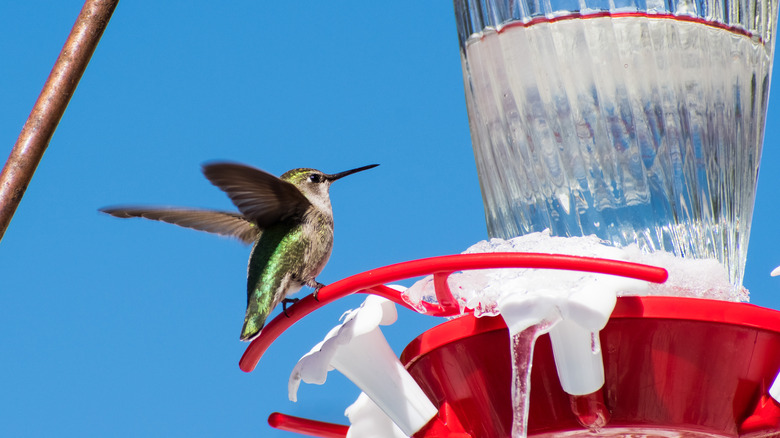Read This Before Investing In Heated Hummingbird Feeders
There's something truly magical about having little hummingbirds flitting around your home and garden. These brilliant, tiny birds can be cloaked in all different colors, from vibrant magentas to shimmering blues and greens. There are many benefits of attracting hummingbirds to your yard, in large part due to their prowess as pollinators. If you live in a colder climate, you may have considered investing in a heated hummingbird feeder to attract hummingbirds to your home during all four seasons. Heated hummingbird feeders work the way you'd expect them to — the base of the feeder heats up, keeping the nectar from freezing solid and becoming undrinkable for the hummingbirds.
According to most users, heated hummingbird feeders work quite well, allowing users to continue feeding their hummingbird visitors during the winter months. However, in extremely cold climates, heated hummingbird feeders might not work well enough to keep the nectar from freezing, and you may be better off bringing your feeder inside during the cold hours of the night. Additionally, it can be dangerous to hummingbirds to use a heated feeder during warmer weather, as nectar that is too hot can harm the birds.
Overall, heated hummingbird feeders are a great way to keep our little hummingbird friends fed all year long. They just need to be used safely and in the proper climate. Regardless of whether you're using a heated hummingbird feeder or a regular one, remember that it's very important for the safety of the birds that you clean your hummingbird feeder often for always-fresh nectar.
Potential issues with heated hummingbird feeders
Before you invest in a heated hummingbird feeder, let's first clear up if you actually need one. There are some misconceptions out there about cold nectar "cold stunning" hummingbirds. In actuality, hummingbirds are way tougher than people think and are more than equipped to handle colder temperatures, which includes sipping on some cold nectar. So if you live in a climate that doesn't freeze, you may not need a heated feeder. However, nectar does freeze at 28 degrees Fahrenheit (-2 degrees Celsius), so if it gets colder than that where you live, a heated feeder may be a good investment. On the other hand, if you live somewhere that gets extremely cold (we're talking below 0 degrees Fahrenheit, or -18 degrees Celsius), your nectar still may freeze, even with a heated feeder. In that climate, you'll likely be better off bringing your feeder inside at night.
It's also important to be mindful of how warm it gets while using a heated hummingbird feeder. Nectar 102.2 degrees Fahrenheit (39 degrees Celsius) and above can seriously harm hummers, so be sure to swap your heated feeder for a regular one if temperatures spike. Heated feeders do use a fairly low-wattage bulb, so this shouldn't be a concern unless it gets really warm.
Another thing to keep in mind with heated hummingbird feeders is they might exacerbate ant problems, as the cord provides another way for sneaky ants to get into your hummingbird feeder. While heated feeders do have a few potential issues, as long as you use them safely and don't have a pest problem, they are a great way to keep hummingbirds fed all winter.

